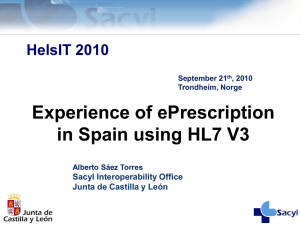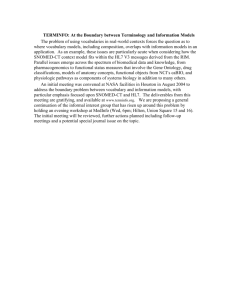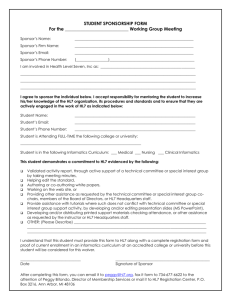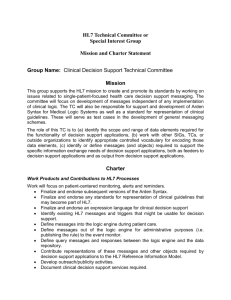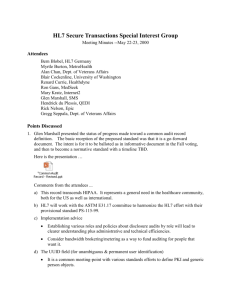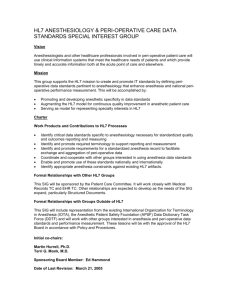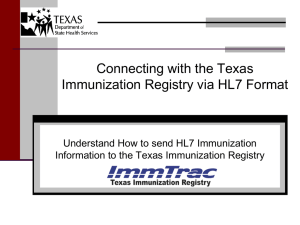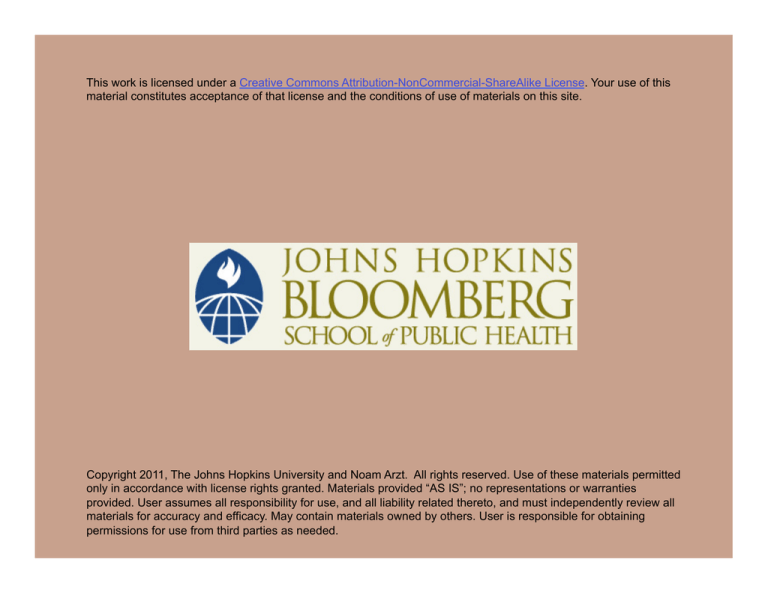
This work is licensed under a Creative Commons Attribution-NonCommercial-ShareAlike License. Your use of this
material constitutes acceptance of that license and the conditions of use of materials on this site.
Copyright 2011, The Johns Hopkins University and Noam Arzt. All rights reserved. Use of these materials permitted
only in accordance with license rights granted. Materials provided “AS IS”; no representations or warranties
provided. User assumes all responsibility for use, and all liability related thereto, and must independently review all
materials for accuracy and efficacy. May contain materials owned by others. User is responsible for obtaining
permissions for use from third parties as needed.
Section C
From Integration to Interoperability
From Integration to Interoperability
“Interoperability is the ability of two or more systems or
components to exchange information and to use the
information that has been exchanged.”
—HL7 EHR Interoperability Working Group
3
HL7 EHR WG Definition
“Coming to Terms” working paper developed in 2006
Compilation and analysis
- 100+ definitions
- Many sources, including HL7, ISO, IEEE, NAHIT, US Executive
Order …
- Approximately 50% — 50% (US/international)
Source: HL7 EHR Interoperability Working Group.
4
HL7 Definition Key Aspects
Technical interoperability
- Structure, syntax, reliable communication
Semantic interoperability
- Full meaning preserved
Process interoperability
- Integral to (health care delivery) process, work flow
5
System-to-System Messaging
Public health systems have been engaged in data exchange for years
(mostly to them)
Though flat file formats still dominate, HL7 messaging is beginning
to gain steam
6
Semantic Interoperability: VT Health Info Tech Plan
Standard
Description
CMS' Healthcare Common Procedure Code
System (HPCPCS)/American Medical
Association (AMA) Current Procedural
Terminology (CPT®) Fourth Edition (CPT-4)
This is the standard coding for procedures widely used in the
healthcare community:
• Level I: hospital outpatient procedures (CPT4)
• Level II: products, supplies and other services
Centers for Disease Control and Prevention
(CDC) Race and Ethnicity Code Sets
These code sets are based on current federal standards
College of American Pathologists
Systematized Nomenclature of Medicine
Clinical Terms (SNOMED CT®)
This is the standard coding used for a wide variety of medical and
health care terms
International Classification of Diseases, Ninth
Edition, Clinical Modifications (ICD-9-CM)
This is the standard coding used for diagnoses and procedures by
hospitals:
• Volume 1 and 2: hospital diagnoses
• Volume 3: inpatient hospital procedures
International Classification of Diseases, 10th
revision, Related Health Problems (ICD-10
CM)
This revision to ICD-9-CM contains a number of important
improvements. This standard is not yet widely implemented
Logical Observation Identifiers Names and
Codes (LOINC®)
This is the standard coding for laboratory and clinical observations
used by health care systems and messaging (like HL7)
National Library of Medicine (NLM) Unified
Medical Language System (UMLS) RxNorm
This is the standard for coding the names of drugs and dose forms
National Drug Code (NDC)
This is a universal product identifier for human drugs
Source: http://hcr.vermont.gov/sites/hcr/files/pdfs/vermont_health_it_plan.pdf
7
Process Interoperability: Immunization Management
Source: AHIC Immunization & Response Mgmt Use Case Diagram: http://www.hhs.gov/healthit/usecases/respmgmt.html
8
From Integration to Interoperability: Why?
To support outwardly-facing projects
To assimilate into an emerging HIE-enabled world
As a bi-product of ARRA/HITECH
Integration
Interoperability
9
How #1: Data-Centered Approach
Data-centered: traditional structures to represent the data being
transported (a row in a file for a record; delimited or fixed length
fields within the record) which goes into a database
- E.g., X12 or HL7 messages
10
How #1: Data-Centered Approach
Data-centered: traditional structures to represent the data being
transported (a row in a file for a record; delimited or fixed length
fields within the record) which goes into a database
- E.g., X12 or HL7 messages
MSH|^~\&|||||||VXU^V04|19970522MA53|P|2.3.1|
PID|||221345671^^^^SS||KENNEDY^JOHN^FITZGERALD^JR|BOUVIER^^^^^^M|1990060
7|M|||~^^^^MA^^^BDL|
NK1|1|KENNEDY^JACQUELINE^LEE|MTH^MOTHER^HL70063|
RXA|0|1|19900607|19900607|08^HEPB-PEDIATRIC/ADOLESCENT^CVX|.5|ML^^ISO+||||||||
MRK12345||MSD^MERCK^MVX|
11
Challenges: Data-Centered Approach (Messaging)
Messages are complex
- Lots of data
“The last mile”—getting data
out of systems
Patient matching
Transport not standardized,
though less of an issue
Multiple versions
- Not backward compatible
- Migration between
versions not trivial
Semantics and coding usually
defined, but still very
challenging
Implementation guides help
cut down the uncertainty
- But still lacking in many
areas
12
How #2: Document-Centered Approach
Document-centered: electronic document where data is prearranged in a structured format which is “filed” in a document
repository
Two primary examples:
- Continuity of Care Record (CCR)
- Continuity of Care Document (CCD)
13
Continuity of Care Record (CCR)
History: Outgrowth of Patient Care Referral Form (PCRF) from the
MA Department of Public Health
Core data set
- Most relevant administrative, demographic, and clinical
information facts about a patient’s health care, covering one or
more health care encounters
- Summary of the patient’s health status (for example, problems,
medications, allergies) and basic information about insurance,
advanced directives, care documentation, and the patient’s
care plan
Source: http://www.astm.org/Standards/E2369.htm
14
Continuity of Care Record (CCR)
Primary use case: snapshot in time containing the pertinent clinical,
demographic, and administrative data for a specific patient
Technical specification
- XML coding that is required when the CCR is created in a
structured electronic format
- Permits users to display the fields of the CCR in multiple
formats
15
Sample CCR
Source: Google Health.
16
Sample CCR
Source: Google Health.
17
Continuity of Care Document (CCD)
History: collaborative effort between ASTM and HL7 as an alternate
to the one specified in ASTM ADJE2369 for organizations committed
to implementation of HL7 CDA
Core data set
- Most relevant administrative, demographic, and clinical
information facts about a patient’s health care, covering one or
more health care encounters
- Standard intended to specify the encoding, structure, and
semantics of a patient summary clinical document for exchange
Primary use case: provide a snapshot in time containing the
pertinent clinical, demographic, and administrative data for a
specific patient
Source: http://en.wikipedia.org/wiki/Continuity_of_care_document
18
Continuity of Care Document (CCD)
Technical specification
- Constraint on the HL7 Clinical Document Architecture (CDA)
standard based on the HL7 Reference Information Model (RIM)
- Basis of many IHE profiles and HITSP constructs
Source: http://en.wikipedia.org/wiki/Continuity_of_care_document
19
Sample CCD
Source: HIMSS EHR Association. All Rights Reserved.
20
Sample CCD
Source: HIMSS EHR Association. All Rights Reserved.
21
IIS Interoperability Model
22

